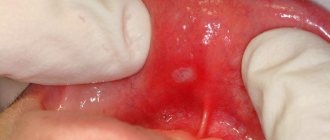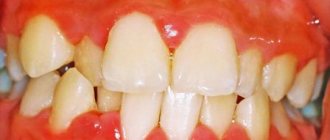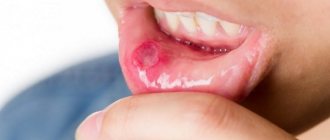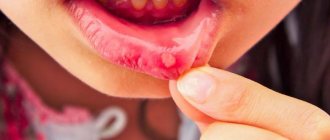One of the most common diseases of the oral cavity is aphthous stomatitis; it is especially common in children. The disease manifests itself as a rash of gray-yellow ulcers (ulcers), which can be found on the inner surfaces of the lips and cheeks, on the tongue, palate and at the base of the gums. In most cases, the rash is represented by one or two ulcers, but massive accumulations of them are also possible.
Other symptoms of aphthous stomatitis in children include:
- bad breath;
- inflammation of the cervical and occipital lymph nodes;
- elevated temperature;
- loss of appetite;
- general lethargy.
Aphthous stomatitis in children is not contagious. The disease can be caused by various pathogens, so before starting treatment, the doctor must determine through tests what caused it. It is usually associated with viral bacteria and occurs as a complication after suffering from influenza, measles, diphtheria and some other diseases.
There are a number of factors that contribute to the development of aphthous stomatitis in children. This:
- decreased immunity due to frequent colds;
- deficiency in the body of iron, zinc, vitamins A, B, C;
- allergic reactions;
- diseases of teeth and gums;
- diseases of the gastrointestinal tract;
- damage to the oral mucosa;
- genetic predisposition.
Causes
To date, the exact etiology of aphthous stomatitis has not been fully identified. The main cause is considered to be a disruption of the immune system (uncontrolled activation of lymphocytes and neutrophils, which begin to destroy epithelial cells). At some point, the immune system ceases to recognize a number of components contained in saliva, which provokes the appearance of characteristic ulcers. However, this is far from the only reason. The aphthous form of stomatitis occurs under the influence of other factors:
- genetic predisposition
- immune system diseases
- gastrointestinal diseases
- neutropenia, Behcet's syndrome
- allergies to sodium lauryl sulfate, citrus fruits, dairy products, grains
- viruses and pathogenic bacteria (staphylococci)
- mucosal injuries
- avitaminosis
- pregnancy
- psychological disorders
What predisposes to recurrent oral aphthae?
Perhaps the microflora of the oral cavity, herpes group viruses, and maybe Helicobacter pylori, a microorganism that causes stomach and duodenal ulcers, play some role.
Also influence:
- injuries to the oral mucosa
- stress
- deficiency of vitamins B12, B1
- vitamin D deficiency
- zinc deficiency
- poor oral hygiene
- nitrates in drinking water
- Sodium lauryl sulfate is a very popular surfactant in the industry, which is often added to toothpastes for better cleaning and foaming effect.
- food allergies (eg, cow's milk protein) or food hypersensitivity (cinnamon, coffee, chocolate, cheese, figs, pineapple, citrus fruits, some spices)
- non-steroidal anti-inflammatory drugs
It is very important to understand: recurrent aphthae is an independent disease (most often this happens) or a manifestation of some systemic disease.
The latter option is rare, but the doctor should always keep in mind the possibility of this situation.
Classification of the disease
Aphthous stomatitis has several forms, which are often directly related to the cause of the disease.
Fibrous
A common form, which is often accompanied by itching, fever and symptoms are much like herpes. Herpetic and aphthous stomatitis differ primarily in the localization of the ulcers. With the aphthous type, they are always located in the mouth and on the tongue (rarely), and not outside, as with herpetic type.
Necrotic
The main causes of necrotizing aphthous stomatitis are somatic diseases and pathologies of the circulatory system. The appearance of aphthae is practically not accompanied by pain, but in the process necrosis of the epithelium and the formation of ulcers occur, touching which already causes significant pain.
Glandular
It occurs due to disruption of the ducts of the minor salivary glands, which is confirmed by the formation of aphthae in this area. Acute respiratory diseases and hypothermia can provoke a relapse of this type of stomatitis.
scarring
Gradular aphthous stomatitis can develop into a scarring stage, in which the ulcers become covered with connective tissue, increase in size and appear even in the palate. Cicatricial aphthous stomatitis takes a long time to treat (ulcers heal for about three months) and requires an integrated approach.
Deforming
The most severe form of the disease. This type of stomatitis leads to deformation of soft tissues and leaves behind noticeable scars.
Types of aft.
Small aphthae is the most common type of aphthae (80-85%). Their size ranges from 1 to 10 mm. Ulcers can appear singly or several at a time (up to five).
Usually heal in 7-10 days.
Large aphthae (10-15%) - more than 10 mm in diameter, can even be up to 3 cm, deeper, take longer to heal (10-30 days).
They may leave scars behind. Very rare in children.
Herpetiform aphthae (5-10%) are small, from 1 to 3 mm, located in groups like herpetic vesicles. They heal quickly, within 10 days. They are not typical for children; they usually occur in the elderly.
The rest of the oral cavity looks normal - there is no inflammation of the gums, redness of the tonsils and pharynx, enlarged and painful cervical lymph nodes.
There is no fever or other general manifestations.
Aphthae in children is manifested primarily by refusal to eat and drink due to pain in the mouth.
The reasons for the recurrence of aphthae are not completely clear; the most popular theory is related to errors in the immune system.
Doctors most often do not find a specific cause of the failure; most likely it is a combination of several factors.
But doctors still have assumptions about some factors.
Acute and chronic
According to the nature of the disease, aphthous stomatitis is divided into acute and chronic.
- Acute aphthous stomatitis. It occurs suddenly, most often due to viral infections and increased concentrations of staphylococci in the blood. Almost immediately, pain occurs and round-shaped aphthae are formed, covered with a grayish coating and having a characteristic red border. The pain makes it more difficult to eat and, in some cases, talk. With timely treatment, the causative agent of aphthous stomatitis is destroyed within 10-12 days, and the epithelial layer at the site of aphthous stomatitis returns to its normal state.
- Chronic (recurrent) aphthous stomatitis. It has been getting worse regularly for many years. This form of the disease occurs in the presence of chronic diseases, as well as under the influence of genetic factors. Recurrent aphthous stomatitis is often accompanied by fever and enlarged lymph nodes. Swelling is observed in the area where afts occur. If left untreated, ulcers begin to grow into the deeper layers of the mucosa: this process is accompanied by slight bleeding and severe pain.
HRAS as a symptom of the disease
Behçet's disease is a disease of unknown etiology, characterized by vascular damage, the appearance of aphthae in the oral cavity and genitals, damage to the eyes, joints, gastrointestinal tract, central nervous system and other organs. It has a chronic course and, if left untreated, can lead to disability.9
Symptoms:
HRAS
HRAS is the earliest symptom of the disease; aphthae can be of any size, recur at least 3 times a year, and are often located on the mucous membrane of the cheeks, lips, gums, tongue
Eye damage
Uveitis (inflammation of the membrane of the eye), blurred vision, “fog” before the eyes, redness of the eyes (rarely), lacrimation
Genital ulcers
Similar to mouth ulcers, but deeper and more painful
Skin redness
The skin exhibits erythema nodosum (red, painful subcutaneous nodules), rash
Other
- vessels in the form of thrombosis, aneurysms
- Nervous system damage: coma, meningitis, confusion
- joints may also be affected in the form of arthritis
Reiter's disease is a systemic infectious disease characterized by damage to the oral mucosa, genitourinary system, eyes and joints.10 The triggering factor for infection is often chlamydia and gonococci, and there is also a genetic predisposition. The disease has a severe course, and in case of complications it leads to disability (blindness, deforming arthritis) and even death.
It is important to remember that HRAS may indicate the presence of a serious systemic disease.
Symptoms
The disease has rather sparse symptoms. Visually, it is easy to identify by the presence of characteristic ulcers on the inside of the lips, cheeks, soft palate and tongue (rarely). Keratinized (fixed) gums are not affected by aphthous stomatitis, which is another difference between aphthous stomatitis and herpetic stomatitis. At the initial stage of aphthae, the patient usually feels discomfort and burning, and the temperature may rise slightly. Diagnosis involves a visual examination, as well as taking blood tests and mucosal smears if the doctor suspects the presence of concomitant diseases.
Diagnostics
If a mucosal lesion occurs in the mouth, the patient is examined by a dentist, infectious disease specialist or pediatrician. To identify the cause of the disease, measures are taken to identify the causative agent of the disease.
The following diagnostic methods are used:
- linked immunosorbent assay;
- cytopolymerase reaction;
- tank sowing discharge from ulcers, pieces of mucous membrane and plaque;
- cytological, immunological research methods.
If candidal stomatitis is suspected, an endocrinologist is consulted and tests are performed to detect diabetes mellitus.
In chronic forms of the disease, the following is carried out:
- tests for worm eggs;
- Ultrasound of the abdominal area;
- immunogram;
- stool examination for dysbacteriosis.
Consultations with a gastroenterologist and immunologist are carried out.
Treatment of aphthous stomatitis
Aphthous stomatitis in adults and children is treated according to the same scheme, the only difference is that some drugs are contraindicated for children, so recommended analogues are used. Treatment is conservative and aimed at eliminating the external manifestations of the disease and causative factors.
Local therapy
Antiseptic rinses and anti-inflammatory gels are used. For speedy healing and epithelization of ulcers, laser therapy, electrophoresis, and treatment of affected areas with Solcoseryl are recommended.
Antihistamines
Recommended if one of the causes of aphthous stomatitis is an allergic reaction. Read more about allergic stomatitis.
Immunomodulators and glucocorticoids
Drugs used to enhance immunity: Prednisolone, Lysozyme, Cyclosporine, Cyclophosphamide and their analogues.
Vitamins
It is recommended to take vitamin complexes containing vitamins C and B12.
Prevention of HRAS
Prevention should be aimed at monitoring the state of health in general, treating chronic diseases, and it is necessary to undergo regular examinations regarding the existing disease. Hardening and strengthening the immune system have a good effect. You need to visit the dentist to monitor your oral health once every 3-4 months to ensure timely detection of relapses. You should avoid using toothpastes, hygiene products with dyes or identified allergens. Taking antibiotics should only be done under the supervision of a doctor. It is recommended to avoid strong psycho-emotional stress and regularly carry out wet cleaning of the premises.
It is worth paying attention to Tantum® Propolis .
Tantum® Propolis
Propolis has an immunostimulating effect, promotes healing, vitamin C, which is part of it, is responsible for regeneration, participating in the synthesis of collagen.
Propolis also has antiviral and antifungal effects. Therefore, vitamin therapy Tantum® Propolis is an effective means of preventing stomatitis12 Find out more
Treatment at home and folk remedies
As an addition to the main therapy, it is possible to use folk remedies. Ginseng, propolis and echinacea are considered good immunomodulators. Infusions of chamomile, propolis or oak bark help cope with inflammation; aloe and sea buckthorn oil promote healing of aphthae. In any case, it is unlikely that you will be able to get rid of the disease using folk remedies alone, so do not delay in visiting a doctor. Timely therapy helps cure aphthous stomatitis and eliminate its symptoms within two weeks. Advanced stages are much more difficult to respond to and can cause irreversible deformation of soft tissues.
Attention!
Conservative therapy implies the possibility of treatment at home, but a visit to a doctor is still necessary, since only a specialist can draw up an optimal rehabilitation plan (including prescribing an ointment, solution, antibiotics, anti-inflammatory drugs, etc.) and track intermediate results.
Recommendations during treatment
It is very important to provide proper hygienic care for the baby during treatment. All toys must be thoroughly washed with hot water and baby or laundry soap. Wet cleaning should be carried out daily. It is best to wash the floors in the children's room with plain water, without adding disinfectants, as they often cause allergic reactions. It is necessary to ventilate the room in which the child spends most of his time at least 6 times a day. The last airing should be done before bedtime and last at least 30 minutes.
Children's dishes and bottles, as well as pacifiers and pacifiers, must be sterilized. To care for the skin, the baby must have his own towel - you cannot use towels used by other family members for this purpose, because the bacterial flora of an adult and an infant is very different.
Remedies for stomatitis in children
To speed up the healing of ulcers and the child’s recovery, you need to:
- keep plenty of fluids (breastfed children should be given breastfeeding “on demand”);
- if the child receives complementary feeding, make sure that all food is in liquid or puree form (the introduction of crackers and baby cookies into the diet should be postponed until complete recovery);
- increase the duration of daytime sleep - this will allow you to quickly restore strength and avoid overexertion, which is contraindicated for sick babies.
Feeding the baby
If, despite all the measures taken, the child’s condition does not improve after three days of treatment, it is necessary to visit the doctor again to rule out other diseases. After recovery, a preventive regimen and measures aimed at strengthening the immune system should be provided: hardening, gymnastics, frequent walks, water treatments. They must correspond to the age and physiological characteristics of the child, so before starting any health procedures it is better to consult a specialist.
Features of treatment in children under 3 years of age
Their stomatitis can only be treated by a specialized specialist. The main task of parents of a sick child is to follow the doctor’s recommendations.
For the treatment of stomatitis the following are used:
- local anesthetic ointments, gels (Lidochlor gel and others);
- antiviral drugs (Acicovir, Ganciclovir);
- antifungal agents;
- antibacterial drugs for local and systemic therapy with mandatory sensitivity testing;
- antihistamines;
- in severe cases, steroid drugs are added;
- local treatment with antiseptics (Methylene blue, Iodinol, Miramistin, Rotokan, Hexoral).
It is important to follow a diet during therapy. Do not give your child irritating foods. After eating, be sure to rinse your mouth with herbal decoctions. It is necessary to monitor oral hygiene. And also wash and treat toys with antiseptics.
Mouth treatment
The most effective measures for treating the disease are rinsing with physiological antiseptics and irrigating the oral cavity with anti-inflammatory sprays.
For treatment of the oral cavity they are used;
- miramistin solution;
- 0.06% chlorhexidine solution;
- 0.02% solution of furatsilin;
- 0.1% dimexide solution.
During therapy, it is important to select medications that provide a quick cure.
The following medications are used for therapy:
- application of anesthetics with proteolytic enzymes for 10-15 minutes once a day (trypsin, lysozyme, ribonuclease);
- applying epithelializing ointments to ulcers (Solcoseryl-gel);
- rinses with antibacterial drugs: Tantum-Verde in a dosage of 15 ml 3-4 times a day, 5-6 days or use Hexoral, Orasept;
- applications of Mundizal gel to the oral mucosa for 20 minutes 3-4 times a day, 5-10 days;
- balm Stomatofit-A, it contains painkillers, extracts of medicinal plants;
- antifungal drugs;
- painkillers, anti-inflammatory ointments (Benzocaine, Xicaine);
- Diphenhydramine suspension to relieve allergic symptoms.











